Paederus Dermatitis / Rove Beetle Dermatitis Pictures

The Rove beetle that is increasingly common in Malaysia. Their bodies contain the toxin paederin (hence Paederous dermatitis) that causes burns on human skin whenever they are crushed. Interestingly the beetles were used to burn off warts in the past. It starts off with some erythema/redness and then with patches of ulceration where the beetle has been crushed. These are some pictures I have collected over the past year in my practice.
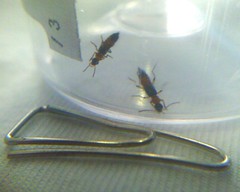 The rove beetles are surprisingly small and very easy to miss. Normally they fly into your house via the windows as they are attracted to light at night. They can fly up apartment blocks and are common if you live near a hill or jungle.
The rove beetles are surprisingly small and very easy to miss. Normally they fly into your house via the windows as they are attracted to light at night. They can fly up apartment blocks and are common if you live near a hill or jungle. Another patch on the arm. The dermatitis normally starts off as a redness or erythema of the skin then continues to become ulcerated.
Another patch on the arm. The dermatitis normally starts off as a redness or erythema of the skin then continues to become ulcerated. Rove beetle /Paederous dermatitis is often confused with shingles or herpes zoster as it's appearance can be similar. However the distribution is not along nerve roots.
Rove beetle /Paederous dermatitis is often confused with shingles or herpes zoster as it's appearance can be similar. However the distribution is not along nerve roots.
A Kissing Lesion occurs when the Rove beetle is crushed between a joint flexure causing identicle mirror lesions.
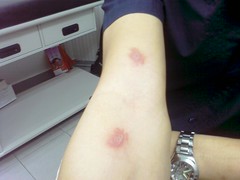
Again most probably a rove beetle crushed in the skin fold of a chubby infant. This produces a mirror image pattern of dermatitis.
More useful info from the SEBERANG PERAI MUNICIPAL COUNCIL.
| Rove Beetle |
| Class : Insecta |
| Order : Coleoptera |
| Family : Staphylinidae |
| Species : Paederus fuscipes Curtis |
| Semut Semai, Semut Kayap, Charlie etc. |
| Estimated 47,000 |
The Rove Beetle is less than 1 cm long. The body is dark orange and the tip of the abdomen, the upper abdomen and the head are black. The upper middle iridescent greenish region of the abdomen are the hard wings (elytra). A pair of transparent wings are neatly folded and hidden under the hard wings. During daytime, the beetle will be seen crawling around swiftly with hidden wings resembling ants. When disturbed it raises the abdomen in a threatening gesture like a scorpion and can fly away. It can also run on water swiftly !
| |||
| Habitat and Feeding Habit | |||
The beetle has been observed in the paddy fields (since 1919), school fields - within the grass etc. It is carnivorous and eats smaller insects. Thus it plays an important role as a biological control of ‘paddy pests’. During heavy rains/ floods, the beetle may migrate to drier areas.
| |||
The haemolymph in the beetle’s entire body (except the wings) contains the most poisonous animal contact toxin in the world called ‘pederin’ (C24 H43 O9 N) named in 1953. It is 12 times more poisonous than cobra venom ! Dried and stored rove beetle for 8 years still retained it’s toxicity ! Contact collision with the beetle while travelling or sleeping, crushing it on the body orsmearing with soiled fingers can cause conjunctivitis and severe dermatitis known as dermatitis linearis, paederus (rove beetle /staphylinidae) dermatitis, whiplash dermatitis etc. In September 2002 an epidemic of dermatitis linearis caused by rove beetles affected thousands of high rise flat dwellers and dormitory students in Penang, Malaysia.
| |||
Since the beetle is attracted to lights at night, switch off or minimise the lighting and close doors/ windows during the beetle epidemic. Use fine mosquito netting, aerosol insect spray, glue traps etc. Do not sit near lights, do not smash the beetle on the body, just blow it away ! If there is contact with the beetle, immediately wash the affected area with soap and water. Those who suffer severe skin reactions should seek medical attention.
| |||
Often whole apartments or housing areas near the hills or forests are filled with these insects at night. Since it is so small, often they are missed and the following day the typical erythematous rash appears. On the second day, pale ulcers appear in the center of the erythematous base where the most contact with the pederin toxin has occured. A burning sensation is present at first then becoming an itchy rash. Most of the time the shallow lesions do not leave a scar, however the deeper ulcers may form a scar if it involves the dermis.
As mentioned before, treatment is firstly the correct diagnosis and assurance that this is not herpes zoster due to it's bizarre distribution.
Secondly prevention of further lesions by checking the sleeping areas for more of these insects and closing the windows in the evening.
Thirdly a mild antiseptic wash like diluted potassium pemanganate (Kmn04) wash, followed by a mild antiseptic plus weak steroid cream is sufficient in most cases. In more serious cases as involvement of the eyes or mucous membranes, or superimposed infection, you should seek medical treatment.
Lastly it is useful to keep the lesions away from direct sunlight as it may lead to post inflammatory pigmentation ie. a dark scar.
It takes about a week for the lesions to heal.
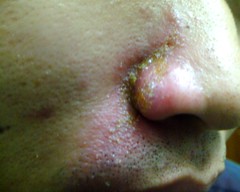

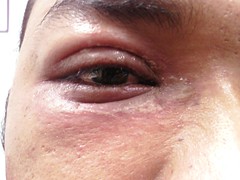

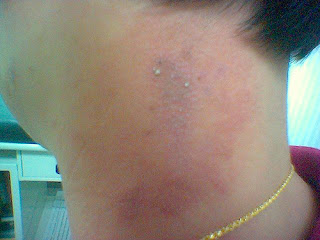



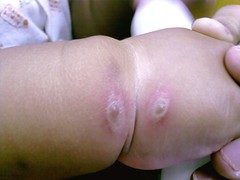
0 comments:
Post a Comment